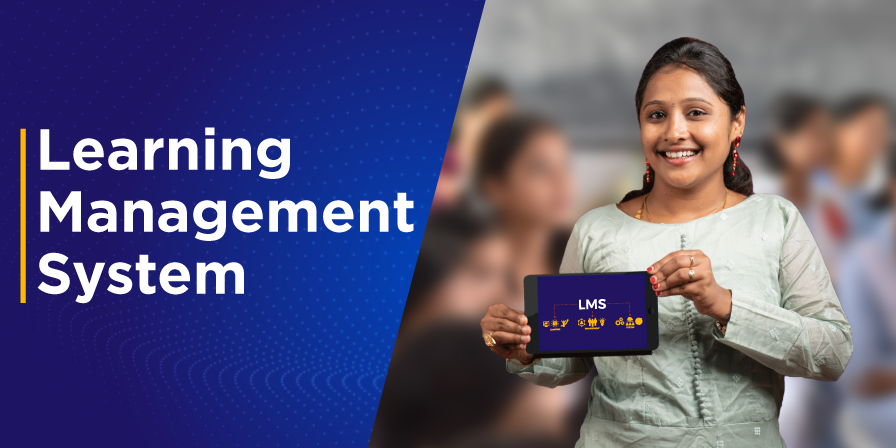Learning Management Systems (LMS) in Education – A Complete Guide

Give Your School The Lead Advantage
The concept of Learning Management Systems (LMS) has gained significant importance in modern education, especially as schools increasingly adopt digital tools.
Today, LMS platforms go beyond just facilitating remote learning; they play a crucial role in enhancing the overall classroom experience, leading to improved student learning outcomes. If you’re curious about how LMS benefits education or want to understand its role better, our detailed guide is here to help.
What is LMS in Education?
Most people who have heard of the software want to know the meaning of learning management system. LMS or learning management system is software designed to manage and support efficient learning. It is a complete teaching solution where instructors can upload course content, and learners can access it through their profiles.
The system supports both face-to-face learning and virtual classes. Apart from that, it also facilitates communication, tracks progress, and keeps records of all important data of students. While it helps the instructors work efficiently, it also caters to the needs of the learners. Overall, it is a system that assists everyone involved in the teaching process.
Why Should You Use a Learning Management System?
After understanding what is LMS in education, you would naturally want to know the benefits of the system. LMS is useful for all teachers and school owners who want to digitize their curriculum. Here are some of the other advantages of using an LMS for e-learning.
1. Higher Engagement Rates
LMS lets instructors create course content in multiple formats. The core curriculum combined with visual and audio content makes the course more engaging for students. Using LMS, you can also source materials from multiple sources to create e-courses in various formats.
As classroom lectures can get monotonous, students who are exposed to diverse learning materials engage more in class and perform better. LMS also makes sure that every student has equal and up-to-date access to the class content. Students can utilize materials that interest them the most and learn through their own preferences.
2. Flexibility
Learning management system for schools gives access to e-learning content anytime and anywhere. You don’t have to worry about creating separate content for virtual teaching. Whether your students opt for classroom or distance learning, they are given access to the same content.
The flexibility provided by the learning management system LMS lets the student learn at their own pace. Whether it is rewatching a video lecture or accessing new content, a student can form their own learning plan. As long as they have login credentials and good connectivity, students can access the content from practically anywhere.
3. Multiple Assessment Options
You can use LMS to monitor student performance and develop a holistic assessment system. Apart from tests and quizzes, the system also lets you track student progress based on the completion of course material. Well-organized student data allows a straightforward approach to monitoring students’ academic performance.
The assessment system goes both ways when using an LMS. Students can also rate the course and provide feedback on the e-learning content. For example, if most of the students vote for a different learning approach for a chapter, you can update the course content accordingly. Tweaking already updated content is easy, so you can provide supplementary material and external references whenever required.
4. Integrated and Scalable Solutions
The need for a learning management system in an educational institute is to improve efficiency and time management. E-learning curriculum management is a multi-step process and requires a variety of features to work feasibly. A good LMS integrates features like calendars, student forums, and communication channels to build a complete solution for e-learning.
Moreover, sharing and marketing your courses on social media platforms is an option through LMS. Since all the lectures, notes, and other learning materials are available on a single platform, adding students to the course isn’t difficult.
For school owners who support multiple course creators, LMS provides scalable options. Adding or removing profiles of teachers and building content systems that cater to each grade is an added benefit of using LMS.
Learning management system examples like enterprise LMS, individual LMS, and on-premise LMS aim to create better learning systems but cater to different requirements.
5. Improved Productivity and Time Management
All assignments and deadlines can be uploaded directly in the LMS, allowing students to view and complete the tasks on time. Even when submitting assignments, students can directly upload them to their LMS profiles.
This integrated system allows the teachers to track submissions and also provide assistance to those who need them. Manually going through records and finding students who haven’t turned in their school work is tedious. The learning management system maintains a record of all submissions, and students who miss deadlines can be held accountable.
The system also serves as proof of all the course work done by a student and all the grades provided by the teacher. Instead of maintaining multiple physical records, teachers can use the data consolidated in a single database.
6. Cost and Resource Saving
A school supports a large number of learners and spends thousands of rupees on printing coursework. This is not only a waste of funds but also harmful to the environment. The LMS is a suitable substitute that provides cost and environment-friendly solutions that cater to the student mass.
Moreover, the content uploaded on the online system is permanent. The resources can be reused for all upcoming batches, making slight changes as and when needed. Combined with other learning management system objectives, cost and resource savings make it the next big technology in the education industry.
Key Features of a Learning Management System
An LMS offers a range of features that enhance both teaching and learning experiences. Below are some of the key functionalities that make an LMS essential for modern education.
Content Management
A Learning Management System (LMS) enables educators to easily upload, organise, and manage various types of educational content, such as videos, documents, and quizzes. This centralised content management makes it simpler for teachers to create cohesive lessons while providing students with easy access to all learning materials.
User Management
LMS platforms streamline user management by defining specific roles for administrators, teachers, and students. Administrators have control over the system’s settings, teachers can create and deliver content, and students gain access based on their needs. This role-based management ensures that everyone has the right tools and permissions within the platform.
Assessment and Evaluation Tools
Assessment and evaluation tools within an LMS allow educators to monitor student progress through quizzes, assignments, and exams. These tools provide real-time insights into student performance, making it easier to identify areas where learners need additional support and tailoring future lessons accordingly.
Integration with Other Tools
An LMS can integrate seamlessly with other educational tools and platforms like video conferencing software, social media, and e-learning resources. This integration enhances the learning experience by providing a more interactive and connected environment for both students and educators.
Scalability and Customisation
LMS platforms are scalable and customisable, allowing educational institutions to tailor the system to their specific needs. Whether it’s adding more users as the institution grows or customising the interface to align with branding, an LMS can adapt to diverse requirements.
How LMS Supports Personalised Learning?
Personalised learning is at the core of effective education. An LMS provides several tools to help create customised learning experiences tailored to each student’s needs.
1. Craft Unique Learning Pathways
An LMS allows educators to design individualised learning journeys for students, catering to their unique learning styles and pace. By offering tailored content and assessments, students can engage in a learning experience that’s specifically aligned with their goals and capabilities.
2. Embrace Mastery-Based Learning
Mastery-based learning emphasises students mastering one concept before moving to the next. An LMS supports this approach by offering repeatable lessons, practice exercises, and assessments until the student achieves the required proficiency.
3. Promote Adaptive Learning Experiences
LMS platforms make Adaptive learning possible by adjusting content and resources based on each student’s performance. This ensures that learners receive the right level of challenge and support throughout their educational journey.
4. Create Learner Profiles and Set Individual Milestones
LMS systems allow for the creation of learner profiles where individual goals and milestones can be set. These profiles help track progress and ensure that every student’s learning pathway aligns with their personal academic objectives.
5. Enable Progress Tracking and Instant Feedback
Progress tracking and instant feedback are critical features of an LMS. Students receive immediate responses to assessments, enabling them to understand areas of improvement quickly. This continuous feedback loop accelerates the learning process and encourages self-assessment.
Using Your LMS for Professional Development
An LMS isn’t just for students—it’s also a powerful tool for educators seeking professional growth and skill development. Here’s how it supports ongoing learning for teachers.
Promote Personalised Learning for Educators
Just as students benefit from tailored learning paths, educators can also pursue personalised professional development using an LMS. Teachers can select courses and training modules that align with their career goals and areas of interest.
Flexibility and Convenience
An LMS provides the flexibility to access professional development resources anytime, anywhere. Educators can complete courses at their own pace, making it easier to balance learning with their existing responsibilities.
Create a Shared Learning Environment with Students
When educators use the same LMS as their students, it fosters a more integrated learning environment. Teachers gain insights into how students interact with the platform, enabling them to improve their course delivery and support.
Cut Down on Time and Cost
LMS platforms reduce the time and cost associated with traditional teacher training methods. Online modules, workshops, and resources are readily available, minimising the need for travel and lengthy in-person sessions.
Foster Professional Learning Communities
LMS platforms encourage collaborative learning among educators by providing forums, discussion boards, and group activities. This fosters professional learning communities where teachers can share ideas, challenges, and best practices.
Choosing the Right LMS for Your School
Selecting the ideal LMS for your school requires careful evaluation of various factors to ensure it aligns with your institution’s needs and goals.
Factors to Consider:
When selecting an LMS for your school, it’s important to focus on factors like user-friendliness, cost, scalability, integration options, and support services. The platform should be easy for both teachers and students to navigate, ensuring seamless use.
Consider the overall cost, including setup, subscription, and potential add-ons, while also ensuring that the system can grow with your institution’s needs. Additionally, look for LMS solutions that integrate well with existing tools like video conferencing and assessment software. Reliable customer support is another key aspect to consider, as it ensures quick resolution of issues during setup and ongoing use.
Implementation Strategies:
To ensure a smooth transition to an LMS, schools should consider these strategies that help streamline the adoption process and effectively train both staff and students.
- Start with a Pilot Program: Begin by rolling out the LMS in a single department or grade to identify challenges and gather feedback before a full-scale launch.
- Provide Comprehensive Training: Conduct training sessions for both teachers and students, focusing on core features, navigation, and troubleshooting.
- Develop a Step-by-Step Onboarding Plan: Introduce the LMS gradually, ensuring that staff and students have time to adapt to the new system.
- Create Support Resources: Develop guides, video tutorials, and FAQs to help users troubleshoot common issues independently.
- Encourage Ongoing Feedback: Regularly collect feedback from users to continuously improve the LMS experience and address any pain points.
How LEAD Group’s LMS Enhances Learning at Your School
LEAD Group’s LMS is designed to transform traditional classrooms by offering a well-rounded, technology-driven learning environment that prioritises improved student outcomes. With a blend of robust features and an innovative approach, LEAD ensures that both educators and students benefit from a seamless learning experience.
LEAD’s LMS supports schools by providing structured lesson plans, assessments, and real-time tracking of student progress. These features enable teachers to deliver consistent and high-quality instruction across classrooms, ensuring that every student receives the same standard of education. Additionally, the LMS is equipped with interactive digital content and videos, making learning more engaging and aligned with modern teaching practices.
Some key features include personalised learning pathways, detailed analytics, and a centralised platform for managing academic content. The system’s user-friendly interface allows teachers to focus more on instruction rather than administrative tasks. By integrating advanced assessment tools, LEAD’s LMS enables data-driven teaching, where educators can tailor lessons based on individual student performance and needs.
Whether it is online learning or face-to-face teaching, LMS has features for everyone. In today’s era, LMS has become an integral teaching tool and is no more a luxury but a necessity. The system helps keep the learning going even during adverse situations. By understanding what is learning management system, you can realise the impact it creates.
If you want to upgrade your entire schooling system or simply create an online course, a learning management system is the perfect solution.
Using technology integrated learning systems, LEAD Group can help you drive visible learning outcomes at your school. Know More

.png)


